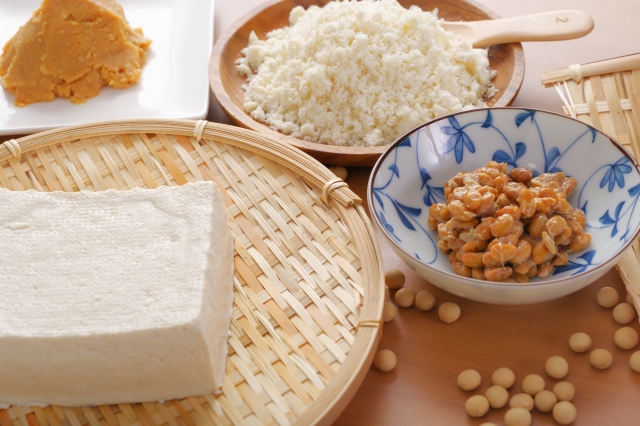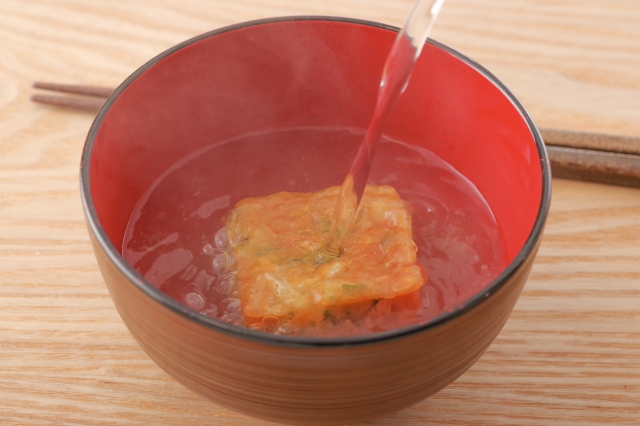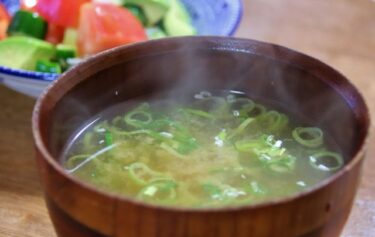Miso soup is a staple of Japanese cuisine, served almost universally with meals at home and in restaurants, especially in teishoku (set meals). It’s a simple, nourishing soup made from miso (fermented soybean paste) mixed into a broth, traditionally called dashi (a stock often made from kelp or dried fish). Miso soup is not just a delicious comfort food but also reflects Japan’s broader use of soy-based and fermented foods, which are common in daily life.
The Role of Soy and Fermented Foods in Japanese Cuisine

In Japan, soy products like soy sauce, miso, tofu, and natto play a major role in the diet. Many of these foods are also fermented, which enhances their flavor and health benefits. Soy and fermented products are known for being high in protein, rich in probiotics, and packed with umami, a savory taste that is essential in Japanese cooking.
Miso, the key ingredient in miso soup, is made from fermented soybeans, rice, or barley, and provides not only flavor but also valuable nutrients. Just like other fermented soy foods, miso contributes to digestive health and adds a unique, slightly tangy flavor to the soup.
Common Ingredients in Miso Soup
Miso soup can be quite versatile, but there are a few core ingredients that are most commonly found:
- Wakame: A type of seaweed, adding a soft texture and a hint of ocean flavor.
- Tofu: Soft cubes of tofu are a common addition, providing a gentle contrast in texture.
- Green Onions (Negi): Sliced green onions bring a fresh, mild flavor and a bit of color to the soup.
Regional Variations in Ingredients
While the basic miso soup is simple, ingredients and styles can vary significantly depending on the region:
- Tonjiru (Pork Miso Soup): In some areas, especially in colder regions, people add pork and root vegetables like daikon (radish) and carrots to create a heartier version of miso soup called tonjiru. This soup is more substantial and filling.
- Kenchinjiru: This is a vegetable-based miso soup with a variety of root vegetables and tofu. It originated from Buddhist vegetarian cuisine, offering a flavorful yet meatless option.
- Nameko Mushrooms: In northern regions like Hokkaido, miso soup might feature local ingredients such as nameko mushrooms, which have a unique slimy texture and a mild earthy flavor.
Different Types of Mis

The type of miso used also varies by region, and this can greatly influence the flavor of the soup:
- White Miso (Shiro Miso): This type of miso is more common in western Japan, particularly in the Kansai region (Kyoto, Osaka). It’s lighter in color and has a sweeter, milder taste.
- Red Miso (Aka Miso): Used more frequently in eastern Japan, especially around Kanto (Tokyo area). It has a stronger, saltier flavor and is darker in color due to a longer fermentation process.
- Mixed Miso (Awase Miso): Some regions blend both red and white miso to achieve a balanced flavor, and this is a popular choice across Japan.
Each region of Japan has its own preferences, and as a result, miso soup can be a delightful reflection of local tastes and ingredients.
When and Where You’ll Find Miso Soup
Miso soup is served with almost every traditional Japanese meal, especially in washoku (traditional Japanese cuisine). Whether you’re having breakfast, lunch, or dinner at a restaurant or at home, miso soup is a familiar and comforting presence. In Japanese restaurants, especially teishoku-ya (set meal restaurants) and izakayas (Japanese pubs), miso soup is a regular part of the meal.
With its rich blend of fermented miso and fresh ingredients, miso soup is not only a cornerstone of Japanese meals but also a nourishing and wholesome dish that embodies Japan’s approach to simple, healthy eating.
Instant Miso Soup: Convenience at Your Fingertips

In Japan, instant miso soup is widely available at convenience stores and supermarkets. These packets allow you to enjoy miso soup anytime, anywhere, with just a cup of hot water. Instant miso soup typically includes freeze-dried ingredients like tofu, seaweed, and green onions, along with instant miso paste or powder. This option is great for those looking for a quick, hassle-free way to enjoy this traditional soup without the need to prepare it from scratch.
How to Make Miso Soup: A Simple Guide
While instant options are popular, making miso soup at home is easy and allows for more control over ingredients and flavor. There are several methods you can use:
1. Making Miso Soup with Fresh Dashi (Stock)
The traditional way to prepare miso soup starts with making dashi, a flavorful broth that forms the base of many Japanese dishes.
- Ingredients for Basic Dashi:
- Kombu (dried kelp)
- Katsuobushi (dried bonito flakes)
Steps:
- Soak a piece of kombu in water for about 30 minutes.
- Heat the kombu water, but remove the kombu just before it starts boiling.
- Add katsuobushi (bonito flakes) and let the water boil briefly.
- Strain the dashi to remove the flakes.
After you have your dashi, simply add miso paste (about 1 tablespoon per cup of dashi) and stir until dissolved. Be sure not to boil the miso once it’s added, as high heat can destroy some of the beneficial probiotics and alter the flavor.
2. Using Instant Dashi
If you’re short on time, you can use instant dashi granules. These are available at most supermarkets in Japan and abroad. Simply dissolve a small amount of granules in hot water to make a quick dashi. From there, the process is the same—add miso paste, stir, and mix in your preferred ingredients like tofu, wakame, and green onions.
3. Making Miso Soup with Miso Balls (Miso Dama)

A modern and convenient trend in Japan is preparing miso balls (miso dama) in advance. Miso balls are small portions of miso paste mixed with dashi and other ingredients, which you can store in the refrigerator or freezer. When you want miso soup, you simply add hot water to the miso ball and enjoy!
How to Make Miso Dama:
- Mix miso paste with a small amount of instant dashi powder or dashi broth until smooth.
- Shape the mixture into small balls, about the size of a tablespoon.
- You can add ingredients like dried wakame, freeze-dried tofu, or green onions directly into the miso balls.
- Store them in the refrigerator for up to a week or freeze them for longer storage.
To enjoy a quick bowl of miso soup, just place a miso ball in a cup, add hot water, and stir. This method is perfect for busy mornings or a quick, nutritious snack during the day.
Whether you’re using fresh dashi, instant dashi, or preparing miso balls, making miso soup at home is simple and allows you to adjust the ingredients and flavors to your taste. With the added convenience of instant miso soup from stores, it’s easy to see why this delicious, nourishing soup is a regular part of daily life in Japan.








